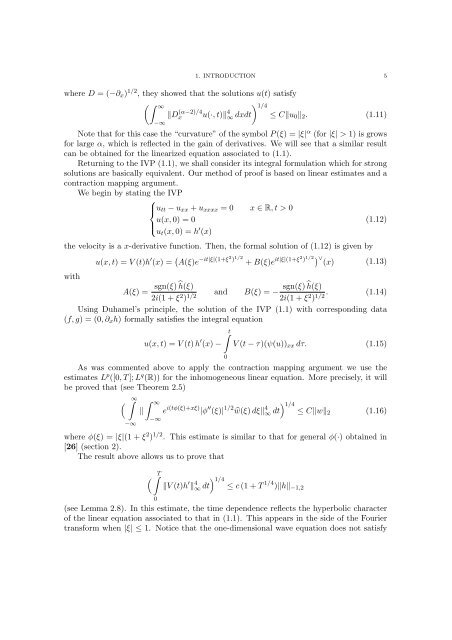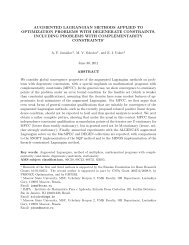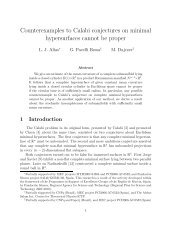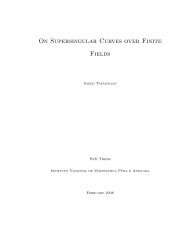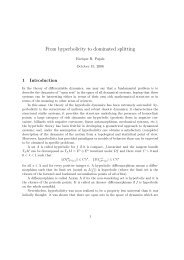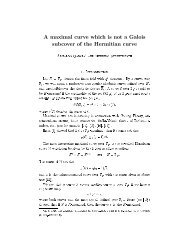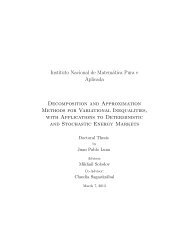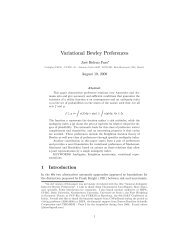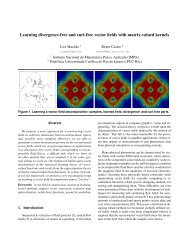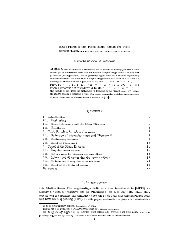Notes on Boussinesq Equation
Notes on Boussinesq Equation
Notes on Boussinesq Equation
Create successful ePaper yourself
Turn your PDF publications into a flip-book with our unique Google optimized e-Paper software.
1. INTRODUCTION 5<br />
where D = (−∂ x ) 1/2 , they showed that the soluti<strong>on</strong>s u(t) satisfy<br />
(∫ ∞<br />
1/4<br />
‖D x (α−2)/4 u(·, t)‖ 4 ∞ dxdt)<br />
≤ C‖u 0 ‖ 2 . (1.11)<br />
−∞<br />
Note that for this case the “curvature” of the symbol P (ξ) = |ξ| α (for |ξ| > 1) is grows<br />
for large α, which is reflected in the gain of derivatives. We will see that a similar result<br />
can be obtained for the linearized equati<strong>on</strong> associated to (1.1).<br />
Returning to the IVP (1.1), we shall c<strong>on</strong>sider its integral formulati<strong>on</strong> which for str<strong>on</strong>g<br />
soluti<strong>on</strong>s are basically equivalent. Our method of proof is based <strong>on</strong> linear estimates and a<br />
c<strong>on</strong>tracti<strong>on</strong> mapping argument.<br />
We begin by stating the IVP<br />
⎧<br />
⎪⎨ u tt − u xx + u xxxx = 0 x ∈ R, t > 0<br />
u(x, 0) = 0<br />
(1.12)<br />
⎪⎩<br />
u t (x, 0) = h ′ (x)<br />
the velocity is a x-derivative functi<strong>on</strong>. Then, the formal soluti<strong>on</strong> of (1.12) is given by<br />
u(x, t) = V (t)h ′ (x) = ( A(ξ)e −it|ξ|(1+ξ2 ) 1/2 + B(ξ)e it|ξ|(1+ξ2 ) 1/2 ) ∨(x) (1.13)<br />
with<br />
sgn(ξ) ĥ(ξ)<br />
sgn(ξ) ĥ(ξ)<br />
A(ξ) =<br />
2i(1 + ξ 2 ) 1/2 and B(ξ) = −<br />
2i(1 + ξ 2 . (1.14)<br />
) 1/2<br />
Using Duhamel’s principle, the soluti<strong>on</strong> of the IVP (1.1) with corresp<strong>on</strong>ding data<br />
(f, g) = (0, ∂ x h) formally satisfies the integral equati<strong>on</strong><br />
∫ t<br />
u(x, t) = V (t) h ′ (x) −<br />
0<br />
V (t − τ)(ψ(u)) xx dτ. (1.15)<br />
As was commented above to apply the c<strong>on</strong>tracti<strong>on</strong> mapping argument we use the<br />
estimates L p ([0, T ]; L q (R)) for the inhomogeneous linear equati<strong>on</strong>. More precisely, it will<br />
be proved that (see Theorem 2.5)<br />
( ∫ ∞<br />
−∞<br />
∫ ∞<br />
1/4<br />
‖ e i(tφ(ξ)+xξ) |φ ′′ (ξ)| 1/2 ŵ(ξ) dξ‖ 4 ∞ dt)<br />
≤ C‖w‖2 (1.16)<br />
−∞<br />
where φ(ξ) = |ξ|(1 + ξ 2 ) 1/2 . This estimate is similar to that for general φ(·) obtained in<br />
[26] (secti<strong>on</strong> 2).<br />
The result above allows us to prove that<br />
( ∫ T<br />
0<br />
‖V (t)h ′ ‖ 4 ∞ dt) 1/4<br />
≤ c (1 + T 1/4 )‖h‖ −1,2<br />
(see Lemma 2.8). In this estimate, the time dependence reflects the hyperbolic character<br />
of the linear equati<strong>on</strong> associated to that in (1.1). This appears in the side of the Fourier<br />
transform when |ξ| ≤ 1. Notice that the <strong>on</strong>e-dimensi<strong>on</strong>al wave equati<strong>on</strong> does not satisfy


